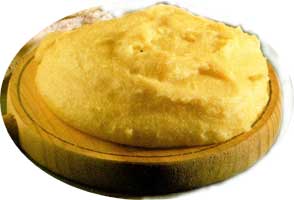Italian Food 2: Polenta
 While pasta is known all over the world, there is another very traditional Italian dish that is relatively unknown: Polenta.
While pasta is known all over the world, there is another very traditional Italian dish that is relatively unknown: Polenta.Polenta is simply coarse, yellow cornflour (cornmeal) boiled with water until it becomes a paste. It is a definitely poor dish, a cheap but filling one. In a sense, polenta in northern Italy has a similar role to rice in Asia: a filling accompainmet to more tasty and precious food, like meat.
To make polenta, one simply has to add cornmeal to a pan of boiling water (I don't remember the exact doses; anyway it is relatively little water), little by little and stirring vigourously with a wooden spoon all the time to avoid the formation of grumes (but as an heretic I prefer to add the cornmeal to cold water and then bring the mixture to the boil: it is the thermal shock of cornmeal being poured in hot water that causes it to coagulate); then add salt to taste and continue to boil stirring until the polenta is quite solid: if you stick the spoon vertically in the middle of it, the spoon should not fall over. When polenta is almost ready one can also add to it a little of olive oil or butter. Typically polenta is then poured on a wooden board as in the picture and served.
Our lovely dish can then be eaten alone, but usually it is topped with a vast choice of food: parmigiano cheese and olive oil for a basic version; other cheese such as gorgonzola for a stronger taste; tomato sauce; sausage (the tasty Italian ones) sauce; mushrooms sauce; bean stew and finally wild boar, rabbit or hare casserole - and even more outlandish things such as snails or frogs. Of course back in the time sauces or even cheese were already luxuries, so the peasants often had to content themselves with whatever they could scrape together: some had one single smoked herring for a whole family, so they lovingly rubbed the herring over polenta to transfer the flavour, and allowed the fish to last for more than one meal. Another recipe involves adding pork and cabbage to the boiling polenta, and the poorest could afford only crushed bones- while people more well-off could add to it even fresh sausage if not fillet meat.
When polenta cools down, it becomes firmer and can be sliced into slices to be deep-fried or grilled later; then used again as a base to be covered with cheese or some sauce. Wafer-thin cured lard, that will melt on the polenta slice, if you really want to try something heavenly.
Gawd, I'm hungry now...

0 Comments:
Post a Comment
<< Home